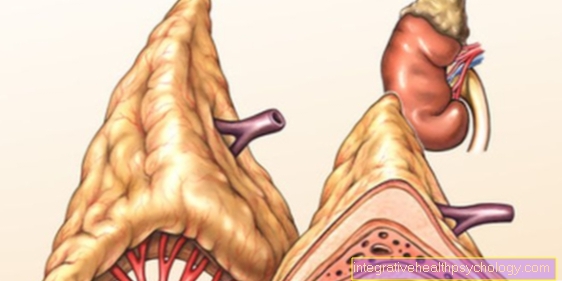The allergic shock
What is an allergic shock?
An allergy shock is referred to in medical terminology as anaphylactic shock designated. This is the maximum variant of an allergic reaction.
Allergy shock can be caused by a wide variety of allergens. It requires immediate medical treatment and is potentially life threatening.

Causes and Triggers
An allergy shock can - like a simple allergic reaction - due to various substances - so-called allergens - to be triggered. However, there are allergens for which it is more likely that an allergic reaction will rapidly develop into an allergy shock after contact with the allergen.
- These allergens include nuts in people with a nut allergy. The most common allergic shock occurs after consuming peanuts and hazelnuts.
- Insect bites caused by insect venom allergies are also a typical trigger of an allergy shock. Wasp stings are by far the most common triggering, followed by bee stings.
- Also certain drugs and substances like latex can trigger an allergy shock. The drugs that can most often trigger an allergy shock include, for example, contrast media that are administered as part of X-ray examinations. Painkillers, especially those from the group of non-steroidal anti-inflammatory drugs, can also trigger an allergy shock. These include, for example, diclofenac, acetylsalicylic acid (ASA), ibuprofen and metamizole (Novalgin ®). Antibiotics are also potential allergens, especially the penicillins.
- Foods include cow's milk products, egg white, soy products, celery, crustaceans / shellfish and wheat products to call.
More information can be found here:
- The causes of shock
- The peanut allergy
- The food allergy
Allergy shock from hay fever
Hay fever is the most common form of allergy in Germany. About 15% of all adult Germans suffer from hay fever.
The triggering allergen are the various pollen. However, it is practically impossible that an allergy shock occurs as part of hay fever. The allergy-triggering pollen causes symptoms such as itchy, watery eyes, runny nose and increased sneezing, but they do not trigger an allergy shock.
You might also be interested in:
- Therapy of hay fever
- Desensitization
Allergy shock from antibiotics
Antibiotics are among the drugs that can potentially trigger allergy shock. Antibiotics from the group of penicillins and cephalosporins in particular carry the risk of causing anaphylactic shock. It is therefore extremely important that people who are already known to be allergic to a certain antibiotic no longer receive this drug for life.
So-called cross allergies must also be taken into account. So people with an allergy to an antibiotic from the penicillin group can also use antibiotics from the cephalosporin group are allergic. Both groups of antibiotics should therefore be avoided in the case of a known allergy to one of the two groups in order to avoid severe allergic reactions and even allergic shock.
More information is available here: Allergy to amoxicillin
Allergy shock from medication
In theory, the body can be allergic to any drug. However, certain drugs have a particularly high allergenic potential. Especially with painkillers from the group of Non-steroidal anti-inflammatory drugs (e.g. ibuprofen or metamizole) and certain antibiotics are known to trigger allergy shock significantly more frequently than other drugs. X-ray contrast media can also cause allergy shock.
Overall, however, allergy shock occurs very rarely after all of the potentially dangerous drugs mentioned. Otherwise the medication would no longer be used regularly. Once an allergic reaction to a drug has occurred, that drug should no longer be used. Otherwise there is a risk of a new allergic reaction or even anaphylactic shock.
Further information on the topic can be found here: The contrast agent allergy
I recognize allergy shock from these symptoms
Allergy shock is a very impressive clinical picture, which in most cases is extreme progresses rapidly. The symptoms are varied.
- After the allergen has been absorbed, allergic skin symptoms such as rashes, itching or flat skin reddening can occur come.
- Furthermore, symptoms in the gastrointestinal tract can occur. These include nausea, vomiting, abdominal pain and diarrhea.
- Symptoms in the respiratory tract such as sudden severe runny nose, hoarseness and shortness of breath can occur in the context of an allergy shock. The shortness of breath can quickly increase significantly as the airways become blocked.
- This can be accompanied by a significant increase in the heart rate (tachycardia) and a drop in blood pressure (hypotension).
The maximum variant of the allergy shock can lead to respiratory or circulatory arrest, which can lead to death.
Read about it too:
- Symptoms of shock
- Resuscitation - you should know that!
diagnosis
The diagnosis of allergic shock can be made without complex diagnostic equipment.
The decisive factor is the anamnesis, i.e. the question of when the symptoms began and especially after ingestion and use of which substance. It is not uncommon for those affected to be people who already know about their allergy and have accidentally ingested some of the allergen. The combination of a recent allergen intake and typical symptoms results in the classic picture of an allergy shock.
The only parameters that are recorded in the allergy shock by means of a "device" are blood pressure and pulse, and possibly also the oxygen saturation.
Read also: The diagnosis of shock
First aid: These are the immediate measures
Immediate action is essential in the event of an allergy shock. People with known allergies who are already at a known increased risk of allergy shock often have an emergency medication kit that must be used as part of an allergic reaction. The most important thing is to use the emergency adrenaline pen immediately. This is injected through the clothing into the side of the thigh.
Learn more about the topic: Allergy - emergency kit
Often, the emergency kit also contains other drugs such as prednisolone or drugs from the group of antihistamines. These should be used as agreed with the prescribing doctor. Even if an emergency medical kit is available, the emergency services should be contacted immediately after using the adrenaline pen.
Also read that Articles on the topic: First aid
This is how the doctor treats allergy shock
The medical treatment of the allergy shock uses the same drugs that are contained in the lay emergency kit. The main drug is adrenaline. This is injected into the muscle. An intravenous line is then usually placed. Other drugs such as antihistamines and prednisolone can be administered through this.
If the airway is severely narrowed, the airway can be secured with a ventilation tube (Tube) become necessary. In the case of cardiac arrest, resuscitation, i.e. resuscitation, may be necessary after the adrenaline injection. This is always followed by rapid transport to the nearest hospital.
You might also be interested in: The therapy of shock
Who needs an allergy emergency kit?
People with known allergies to foods such as nuts in particular and people with known insect venom allergy should always have an emergency kit. Even people who have already suffered an allergy shock and for whom the trigger cannot be safely avoided should have an emergency kit.
It is absolutely crucial that this emergency kit is always and everywhere with you. Those affected should also have an allergy passport with them. This can be necessary if you become unconscious as a result of an allergy shock and are dependent on outside help. People who do not know the person concerned can use the allergy pass to assess the emergency much faster and act accordingly.
More information here:
- Allergy pass
- Allergy emergency kit
Duration of allergic shock
Allergy shock usually develops acutely and progresses rapidly. It can develop into a life-threatening clinical picture within a few minutes.
An allergy shock always requires drug treatment. With timely and adequate treatment, the acute symptoms usually recede very quickly.
This is how dangerous an allergy shock can be
Allergy shock is a life-threatening condition.
A respiratory or circulatory arrest can develop within minutes, which is fatal if appropriate countermeasures are not initiated in good time. It is therefore essential that people who are already known to be at increased risk of allergy shock have an emergency kit and an allergy passport. You must always carry both with you. In addition, in the case of known allergies, avoidance of the allergen is essential if possible.
Learn more about: Prognosis and prophylaxis of shock
That can be the consequences
The most fatal consequence of the allergy shock is death.
Often times, the anaphylactic reaction progresses so rapidly that it can occur within minutes if not adequately treated. If an allergy shock is treated successfully, there are usually no long-term consequences.
Recommendations from our editorial team
- The septic shock
- The animal hair allergy
- Testing for a food allergy
- Wasp sting - first aid and emergency measures
- Domestic emergencies





























